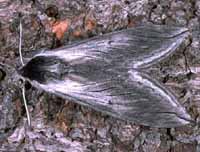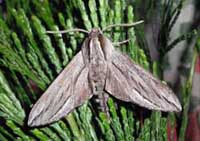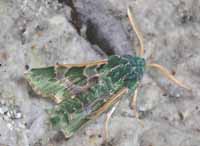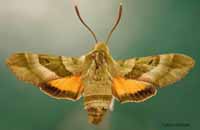Sphinginae subfamily
Sphingini tribe:
 |
This large bodied moth flies in tobacco fields and vegetable gardens
(potatoes, tomatoes) and wherever host plants are found. |
 |
If you grow tomatoes, you have probably encountered it.
Larvae get very large and can strip a tomato plant. |
 |
Sphinx chersis
USGS, the Northern Ash
Sphinx or Great Ash Sphinx
The upperside of the forewing is soft dark-gray to blue-gray with
a series of black dashes, one reaching the wing tip. Note grey
thorax with narrow black lines.
|
 |
Forewings, long and slender, are held close to the body when the moth
is at rest.
I only see them occasionally on P.E.I. despite visiting lights
frequently. |
 |
Sphinx perelegans adults fly in montane woodlands and mixed chaparral-type vegetation as a single brood
in the north, with adults mainly on the wing in June and July.
It flies from dusk until after midnight. Note dark thorax. |
 |
Adults fly as a single brood in the desert and in pinyon-juniper
woodland from May to August. |
Smerinthini Tribe:
 |
This one is quite similar to Pachysphinx modesta, with modesta
being smaller and darker.
Moths should be on the wing from June-August.
|
 |
Smerinthus cerisyi
USGS/MB, the Cerisyi's
Sphinx or One-eyed Sphinx, Larvae feed on poplars and willows.
Flight would be from mid April-July as a single brood.
|
Smerinthus cerisyi, Mike Belcher, Sebastopol, April 13, 2008
Macroglossinae subfamily
Dilophonotini Tribe:
 |
Hemaris thetis USGS, the Thetis Clearwing or Bee Hawk Moth,
The moth flies along forest edges and in meadows, gardens and
brushy fields. Day-flying adults nectar at lantana, dwarf bush honeysuckle,
snowberry, orange hawkweed, thistles, lilac, Canada violet, etc.
|
Philampelini Tribe:
 |
This species should be present wherever grapes are found.
Fight would be from June to August. Larvae feed on grape foliage. |
Macroglossini Tribe:
 |
Arctonotus lucidus
USGS, the Pacific Green
Sphinx Moth or Bear SphinxThis species is confirmed in Sonoma
County.
It tends to be an late winter-early spring flier, on the
wing in the early evening. It comes to lights at night. |
 |
Hyles lineata
USGS,
the White-lined Sphinx
Adults usually fly at dusk, during the night, at dawn, and during the
day. Moths nectar at salvia and oviposit on Epilobium cana
(California fuchsia) and Hooker's Evening Primrose. |
 |
Adults fly in the afternoon from April-June in oak woodland and
pine-oak woodland in foothills, nectaring from chia, heartleaf
milkweed, golden currant, bluedicks, fairyfans, vetches,
thistles, hedgenettles, etc. |
|
|
